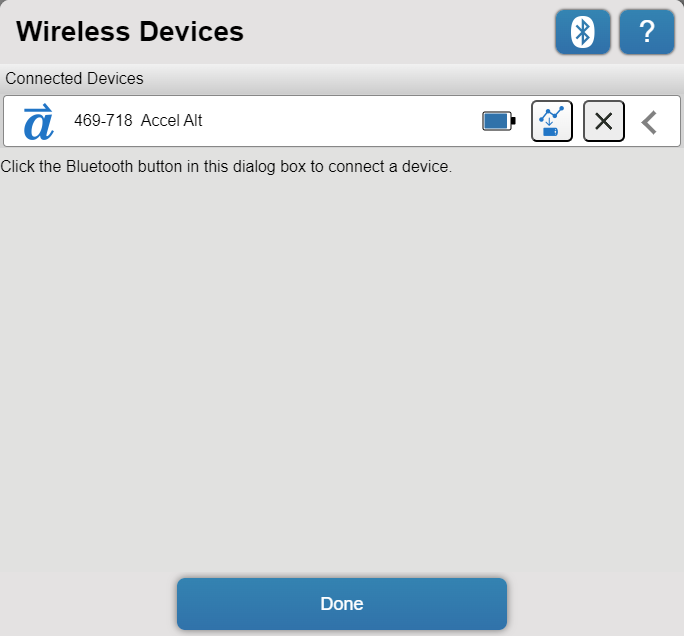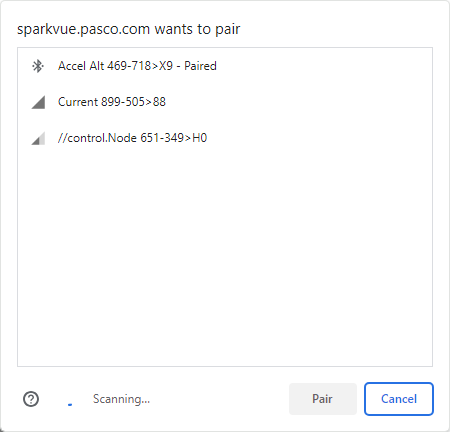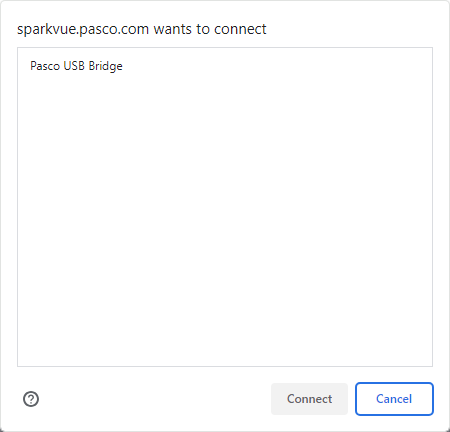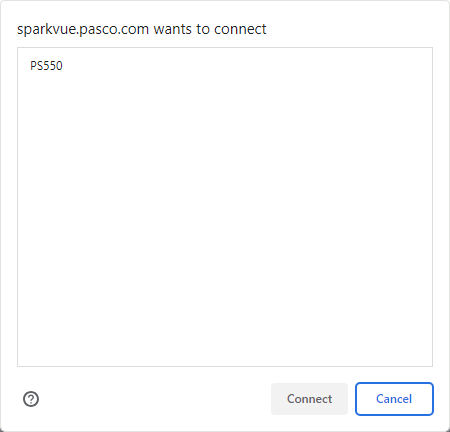Connect a sensor from the Experiment Screen
After opening a saved experiment, PASCO experiment, or building a new experiment, you can connect your sensor from the Experiment Screen.
You can connect a PASCO Wireless, PASPORT, or ScienceWorkshop sensor to SPARKvue. The steps required are different for each type of sensor, so navigate to the instructions for your sensor using the Table of contents on the right.
Tip
If you're starting a new experiment from scratch, the easiest way to get started is to use the Sensor Data path from the Welcome Screen. See Set up and display sensor data.
Note
The PWA version of SPARKvue features a slightly different method of connecting sensors. If you are using the PWA version of the program, go here for information on this method.
Wireless Sensors
You can connect Wireless Sensors directly to SPARKvue using Bluetooth or USB.

-
Turn on the sensor by pressing the power button until the lights turn on.
-
Click the Bluetooth
 button on the upper toolbar to open the Wireless Devices window.
button on the upper toolbar to open the Wireless Devices window. -
Select the sensor that matches the device ID printed on your sensor.
-
Click Done.
You can connect Wireless Sensors that have a USB port directly to a PC, Mac, Chromebook, or Android device.
Connect the sensor to the device's USB port using a USB cable. The sensor turns on and connects to SPARKvue automatically.
Tip
Click  to confirm that the sensor connected successfully.
to confirm that the sensor connected successfully.
PASPORT Sensors
Connecting PASPORT sensors to SPARKvue requires a PASPORT interface. Depending on the interface, you can connect using Bluetooth or USB.

-
Turn on the interface.
-
Pair the interface with your computer or mobile device using your device's Bluetooth settings.
Note
Pairing is not needed if using an AirLink Interface.
-
Click
 to open the Wireless Devices window.
to open the Wireless Devices window. -
Select the interface that matches the device ID printed on your interface.
-
Click Done.
-
Connect the sensor to a PASPORT port on the interface.
Tip
Click
 to confirm that the sensor connected successfully.
to confirm that the sensor connected successfully.
-
Power on the interface.
-
Connect the interface directly to a PC, Mac, Chromebook, or Android device using a USB cable.
-
Connect the sensor to a PASPORT port on the interface.
Tip
Click
 to confirm that the sensor connected successfully.
to confirm that the sensor connected successfully.
ScienceWorkshop Sensors
ScienceWorkshop Sensors can be either digital or analog. Digital sensors have a 1/4" audio plug. Analog sensors have an 8 pin DIN plug.
Note
The 850 Universal Interface and legacy ScienceWorkshop interfaces are not compatible with SPARKvue.
Analog sensors
Connecting analog Science Workshop sensors requires a 550 Universal Interface or a PASPORT interface with an Analog Adapter. Depending on the interface, you can connect using Bluetooth or USB.

-
Turn on the interface.
-
Pair the interface with your computer or mobile device using the device's Bluetooth settings.
Note
Pairing is not needed if using an AirLink Interface.
-
Click
 to open the Wireless Devices window.
to open the Wireless Devices window. -
Select the interface that matches the device ID printed on your interface.
-
Click Done.
-
Connect the sensor to an analog port on the interface.
-
Click
 .
. -
Click Properties
 for the channel that you connected the sensor to.
for the channel that you connected the sensor to. -
In the Assign Analog Adapter window, select the sensor in the list, then click OK.
Tip
If desired, the gain of the sensor can be changed from the Assign Analog Adapter window by clicking the box next to Gain and selecting a value from the list. The default gain setting of Low (1x) works well for most applications.
-
Click the right arrow
 to close Hardware Setup.
to close Hardware Setup.
-
Turn on the interface.
-
Connect the interface directly to a PC, Mac, Chromebook, or Android device using a USB cable.
-
Connect the sensor to an analog port on the interface.
-
Click Hardware Setup
 .
. -
Click Properties
 for the channel that you connected the sensor to.
for the channel that you connected the sensor to. -
In the Assign Analog Adapter window, select the sensor in the list, then click OK.
Tip
If desired, the gain of the sensor can be changed from the Assign Analog Adapter window by clicking the box next to Gain and selecting a value from the list. The default gain setting of Low (1x) works well for most applications.
-
Click the right arrow
 to close Hardware Setup.
to close Hardware Setup.
Digital sensors
Connecting digital ScienceWorkshop sensors to SPARKvue requires a 550 Universal Interface or a PASPORT interface with a Digital Adapter. Depending on the interface, you can connect using Bluetooth or USB.

-
Turn on the interface.
-
Pair the interface with your computing device using your device's Bluetooth settings.
Note
Pairing is not needed if using an AirLink Interface.
-
Click
 to open the Wireless Devices window.
to open the Wireless Devices window. -
Select the interface that matches the device ID printed on your interface.
-
Click Done.
-
Connect the sensor to a digital port on the interface. The Assign 550 Digital Channels window appears.
-
Select one of the menu items to expand the list.
-
Select a device or timer from the list.
-
If prompted, enter the properties for the device or timer.
-
Click OK.
-
Turn on the interface.
-
Connect the interface directly to a PC, Mac, Chromebook, or Android device using a USB cable.
-
Connect the sensor to a digital port on the interface. The Assign 550 Digital Channels window will appear.
-
Select one of the menu items to expand the list.
-
Select a device or timer from the list.
-
If prompted, enter the properties for the device or timer.
-
Click OK.
Connecting sensors in the PWA version
The PWA version of SPARKvue has slightly different procedures for connecting a device on the Experiment Screen. If you are using the PWA version of the program, follow the appropriate instructions below to connect a sensor from the Experiment Screen.
Wireless Sensors
-
Turn on the sensor by pressing the power button until the lights turn on.
-
Click or tap the Bluetooth
 button on the upper toolbar to open the Wireless Devices window.
button on the upper toolbar to open the Wireless Devices window. 
-
From the Wireless Devices window, click the New Bluetooth Device
 button to open a list of available Bluetooth devices.
button to open a list of available Bluetooth devices. 
-
Select the sensor with a device ID matching the ID printed on your sensor, then select Pair.
- Click Done to return to the Experiment Screen.
- Turn on the sensor by pressing the power button until the lights turn on.
-
Click
 to open a list of available USB devices.
to open a list of available USB devices. 
-
Select Pasco USB Bridge from the list of devices, then select Connect.
PASPORT and ScienceWorkshop Sensors
PASPORT and ScienceWorkshop analog or digital sensors can be connected to the PWA version of SPARKvue from the Experiment Screen in mostly the same way as the standalone app version. However, the PASPORT, analog, or digital interface will need to be connected in the same way as a Wireless Sensor, either via Bluetooth or USB. Follow the appropriate directions above to connect the interface, then plug the sensor into a corresponding port on the interface and proceed as normal.
Note
When connecting an interface to your browser via USB, the name of your interface may be listed instead of "Pasco USB Bridge". For example, a 550 Universal Interface will be listed as "PS550" in the menu. All other connection steps will be the same as described for Wireless Sensors.
